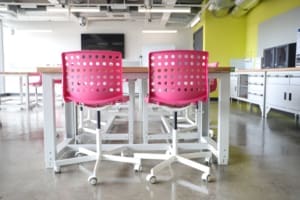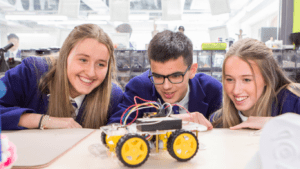Innovation at KA

Scotland’s School of Innovation
In September 2019, Kelvinside Academy launched Scotland’s School of Innovation, the first of its kind in the UK. Inspired by an architecture studio model, learning at the school focuses on real-world challenges and collaborative problem-solving rather than traditional exams.
All of Kelvinside Academy pupils – from J1-S6 – can benefit from this innovative approach, pushing the boundaries of conventional education to foster creativity and critical thinking.


Easter Innovation Camp
Monday 7 April – Thursday 10 April 2025
The Innovation Camp is designed to enhance creativity and engineering skills. Throughout the week, participants will engage in enjoyable problem-solving activities resulting in two thrilling competitions: one featuring radio-controlled micro-bots and another showcasing their LEGO SPIKE-designed robots. There will also be engaging experiences within the school, ensuring each day is memorable.
This Camp is open to children from all schools in P7-S3.

Industry Partnerships
Based on the architectural studio model it will be geared around multidisciplinary, collaborative projects. Partnerships will be formed with Scottish Industry and Academia so that young people can gain insight, experience and teaching direct from industry.
To discuss a partnership with our Innovation School, please email David Sassarini, Director of Educational Technology and Innovation at david.sassarini@kelvinside.org.
As well as disrupting education, the building is a beacon for the construction sector as it is the country’s first sustainable building designed and constructed using circular and eco-design principles.
“We are delighted to be partnering with Kelvinside Academy, in a relationship which shares our vision of reducing onsite activity by 25% by the year 2025 and will help us develop our future talent. We have worked closely with Kelvinside Academy to ensure a collaborative design process and maximise efficiencies through circular and eco-design principles, which are designed to minimise waste and capitalise on resources. We look forward to successfully delivering this unique project and developing close links between the school and industry for years to come.”
Hector MacAulay, Balfour Beatty’s Regional Managing Director for Scotland and Ireland
Kelvinside Academy presented the disruptive aims of Scotland’s School of Innovation at their recent Disruptive Innovation Festival (DIF). The DIF is an online platform which aims to shift mindsets and inspire action towards a circular economy. It invites people to share disruptive ideas and stories on a number of topics, and attracts a worldwide audience, sparking critical conversations and participation through a combination of live interviews, films, and podcasts.
